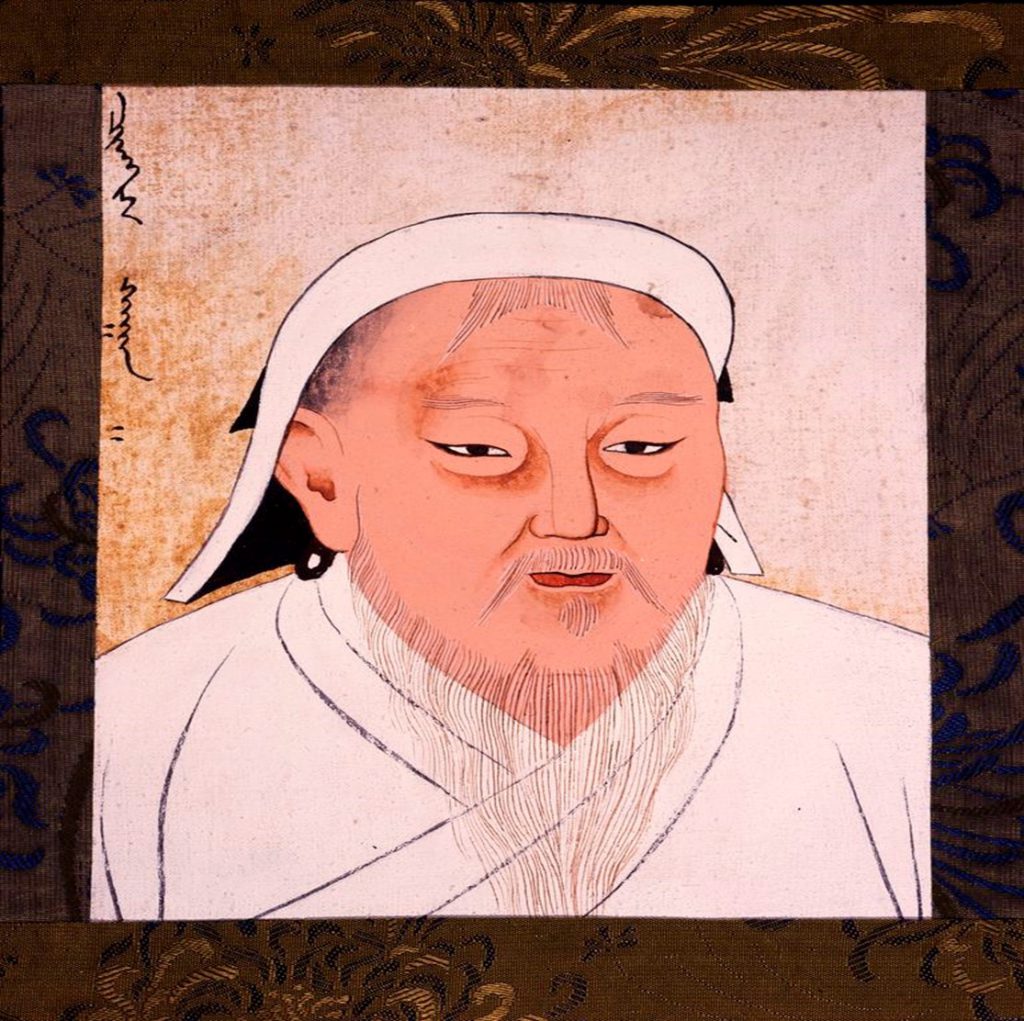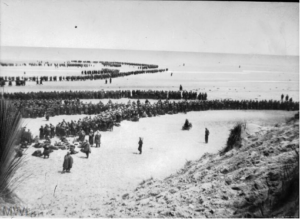Napoléon and Europe, Alexander and Persia, Ashoka and India. All famous conquerors and their conquests, but none compare to the heights reached by Genghis Khan. The Mongolian Empire was the biggest empire of all time. The expansion of the Mongolian Empire began in northern China, which was home to the Xi Xia and the Jin Empires.1 Genghis Khan’s leadership skills were first put to the test in the fierce battles to take over northern China.
Long before Genghis Khan, however, the nomadic peoples of the Asian steppes had invaded northern China for centuries. The peoples of the steppes are known for their constant migration, not for their civilizations. They are peoples who hunt and herd, not grow and harvest. But they are also a people who can be soldiers, knowing well how to attack and to kill.2 Almost every Mongolian learned to ride a horse at a young age, and they learned how to travel and to attack. One scholar has stated that “Babies rode before they could stand. When they grew up, sitting in the saddle was probably more natural to them than walking.”3 These nomadic peoples lacked the wealth and riches that were plentifully found in the more sophisticated civilizations of the river valleys, like that of its neighbor to the south along the Yellow River. For that reason, nomads like the Mongols had been invading northern China for centuries in order to obtain riches they did not have.

It would not be until Genghis Khan had united all the tribes of the eastern Asian steppes that the Mongolians would have their turn at attacking China. Their attacks, however, would not be for mere spoils from their raids, but to conquer the Xi Xia and Jin empires. It was the year 1206 that Genghis Khan became the leader of the tribes of the steppes, after killing his childhood best friend Jamuka, who had opposed his rule for many years. He then consolidated his power, and he imposed on his people two rules: tolerance of other religions, and loyalty.4. This became especially handy when moving into the Xi Xia Empire. Every single troop of his army would lay down his life for the Great Khan because he knew that Temüjin (Genghis Khan) would do the exact same for him.5 Since the Mongols could not attack the Chinese of Xi Xia head on, they needed a plan. That plan would be an attack of the flank on the western side of the Xi Xia. He simply could not just attack the Xi Xia and Jin Empires head on, because they had millions more people. Even though the Mongolians were great fighters after having fought each other for centuries, they would not have a chance against so many people.
Genghis Khan wanted to bring power and wealth to his people, and wealth is what the Chinese had.6 China itself was too large for Genghis Khan to conquer. China was actually three empires: the Xi Xia Empire (or Western Xia), the Jurchen Jin Empire to its east, and the Song Empire to the south. And because the Song was south and east of the other two, it was therefore out of reach for Genghis Khan, at least, for the moment. Genghis Khan had his eye on the wealth that the Xi Xia and the Jin Empires had gained from their controlling of the Silk Road trade routes across Asia. These Silk Roads traded goods from all over Asia and into Europe, and they promised great wealth to whomever controlled them.7 In order for Genghis Khan to conquer the Jin, he first had to conquer the Xi Xia in order to defend his flank on the western side. By securing that flank, he could then better attack the Jin by attacking on two fronts, from the north and from the west. Xi Xia, to the west of the Jin Empire, was just south of the Gobi Desert. In addition, the Xi Xia were a farming and trading people, but also a people of fighters having to constantly fight their larger neighboring empires and other nomadic groups from the steppes. The problem was that the Mongols had never fought against fortified cities, like those of the Xi Xia. This would prove problematic for Genghis Khan, but instead of giving up, he proved why he is the greatest leader in history. The attacks on the Xi Xia Empire would give Genghis Khan and his army the experience they needed in fighting fortified cities.8

The invasions started in 1206. Their purpose was to give the Mongolians a knowledge of the land that they would later be invading for the purpose of conquering. Genghis Khan also wanted to test his men and his number one rule: gain the loyalty of his local tribes. Then, leading the charge across the Gobi desert, Genghis Khan began his main assault on the Xi Xia Empire in the spring of 1209. The Mongols had major problems attacking the city Volohai, which was located on the eastern side of the Xi Xia Empire. They had no experience in fighting large scale battles. For example, in the city of Volohai, the Mongols were unsuccessful in taking over the city with brute force, so they had to implement another strategy.9 Genghis Khan sent the leader of Valohia a message saying that he would abandon the city if the leader of Valohia gave him all of their bird and cats. The leader agreed to the Khan’s offer in order to save his people from even more war with the Mongols. However, Genghis Khan did not keep his word. He had the Mongols tie cotton to the cats’ tails and light them on fire. The scared animals fled back to the city, igniting the town of Volohai on fire. The Mongols scraped up anything salvable, and with that, they had won their first fight against a fortified city.10

The success at Volohai was just the beginning of Genghis Khan’s list of accomplishments, but it was the first time that they had taken a fortified city of that size. That following summer, in 1210, the Mongols raided the entire countryside of the Xi Xia. Genghis Khan quickly moved on to the capital city Ningxia located along the Yellow River. But by the time they reached Ningxia, Genghis Khan had to decide to either continue their assault on Xi Xia, or pack it up because of the approaching winter. Historian Paul Lococo states, “The Mongols built a dam along the Yellow River, hoping to divert the water into the city. But at this time, the Mongols’ engineering skill was poor and the water was diverted to the Mongol encampment rather than the city.”11 Luckily for Genghis Khan, Burkhan Khan, the leader of the Xi Xia who was living at the capital, said to Genghis Khan, “I’ll surrender to you and be like your right hand, giving all my strength to you.” He gave Genghis Khan one of his daughters, Chakha, as a wife, and sent a message with her, saying:
“When we heard tale of what Genghis Khan had done, we were afraid of him. Now that we see him before our city walls, we are afraid of his greatness and power. This fear makes us say, ‘We’ll be your right hand and give all our strength to you.’ But when we say we’ll give you all our strength, remember that we’re a people whose camps don’t move [like those of the Mongols], we’re a people who’ve built city walls. Though we’ll be your allies, when you go off to fight a swift campaign or quick fight, we won’t be able to rush off and fight beside you. But if Genghis Khan will spare us, we Tangut will give him the camels we raise … the woolen clothing and satins we weave, [and] the best of the birds we’ve trained for the hunt.”12

Genghis Khan’s conquering ambitions led him on to attacking the Jin Empire to fulfill his dream of conquering northern China. The Xi Xia Empire secured his flank in order to make a move on the Jin. However the Jin Empire would be the largest empire for Genghis Khan to conquer, populated as it was with millions of people.13 Sadly, he was never able to fulfill that dream, as he died in the year 1227. The Mongolian Empire reached the size of 4,600,000 square miles at the time of Genghis Khan’s death. It would be almost a decade later when the Mongolians finally fulfilled Genghis Khan’ s dream of taking over all of northern China.14
- Don Nardo, Genghis Khan and the Mongol Empire (Detroit, Mich: Lucent books, 2010), 55. ↵
- Don Nardo, Genghis Khan and the Mongol Empire (Detroit, Mich: Lucent books, 2010), 16-18. ↵
- Peter Brent, Genghis Khan: The Rise, Authority, and Decline of Mongol Power (New York: McGraw-Hill, 1976), 29–30. ↵
- Don Nardo, Genghis Khan and the Mongol Empire (Detroit, Mich: Lucent books, 2010), 37-38. ↵
- Don Nardo, Genghis Khan and the Mongol Empire (Detroit, Mich: Lucent books, 2010), 42-43. ↵
- Don Nardo, Genghis Khan and the Mongol Empire (Detroit, Mich: Lucent books, 2010), 54. ↵
- Paul Lococo, Genghis Khan: History’s Greatest Empire Builder (Washington D.C.: Potomac books, 2008), 37. ↵
- Paul Lococo, Genghis Khan: History’s Greatest Empire Builder (Washington D.C.: Potomac books, 2008), 38. ↵
- Paul Lococo, Genghis Khan: History’s Greatest Empire Builder (Washington D.C.: Potomac books, 2008), 38-39. ↵
- Michael Prawdin, The Mongol Empire: Its Rise and Legacy (New York:Free Press, 1967), 108. ↵
- Paul Lococo, Genghis Khan: History’s Greatest Empire Builder (Washington D.C.: Potomac books, 2008), 39-40. ↵
- Paul Khan, The Secret History of the Mongols (San Francisco: North Point Press, 1984), 148-49. ↵
- Paul Lococo, Genghis Khan : History’s Greatest Empire Builder (Washington D.C.: Potomac books, 2008), 40-41. ↵
- Paul Lococo, Genghis Khan : History’s Greatest Empire Builder (Washington D.C.: Potomac books, 2008), 49. ↵



21 comments
Genesis Vera
I loved the fact that this article focuses on Genghis Khan but still provides background information on China. There is so much history that comes with Genghis Khan story and the author does a great job of only providing necessary information. The images used were perfect because it allows you to visualize Khan while reading the story.
Kayla Sultemeier
I have never taken the time to learn or read about Genghis Khan, so this was very informative! I get massively confused when discussing the different empires that have taken place or preceded over Chinese history, and it was one of my biggest confusions when I took World History in high school, so I am glad that your article was intriguing enough for me to learn something! Excellent job!
Samson Pullattu
The Mongols had only started their infamous conquering and they had already toppled an empire. To force the Xi Xia Empire into surrendering and for their leader to offer his service and daughter to save his city is astounding considering how new of a threat the Genghis Khan and his army was. It’s no surprise that the Mongols managed to conquer lands to create such a humungous empire that lasted for many years.
Alexis Lopez
This article was an interesting read and very informative as well. I actually have never heard of Genghis Khan’s Conquest of the Xi Xia which made it more interesting and fun to read. I think the article was written in a great way to grab the attention of the audience from beginning to end. I also loved the fact that I was able to learn about the different empires that China had and being able to specifically take a deeper dive of Genghis Khan.
Erin Vento
This was a really interesting and informative article! Before reading this, I only really knew Gengis Khan by name, and some weird fun facts from tv, but I really enjoyed learning about who he really was. I really had no idea that he was all for religious tolerance and loyalty or even that he was such an ambitious and successful conqueror.
Shriji Lalji
A very interesting article that really informed me on the the reach of Genghis Khan. I was aware that he was a great conquerer but never knew to what extent. However, I have also learned how him and his army would set fire to towns as the article mentions, but they also raped women and slaughtered men, women, children and babies. I guess when you want to be a conquerer of Khan’s level mercy is not in your vocabulary. I was hoping the article would mention how he died.
Jakob Trevino
Ghengis Khan conquest across Asia has to be one of the most interesting conquests to read about. Like the author had mentioned, yes we have Ashoka and Napoleon, but the fact that Gengis Khan had covered so much land and ruled it was interesting. This was a great story, very informative.
Madeline Chandler
Such an interesting and informative article!! I have obviously previously heard of Genghis Khan however not any element of this story or to this detail. So very captivating, you really pulled in your audience. I have never heard unity of tribes and invasions of Genghis Khan, so it was so cool to learn about something from history I had not known. I thoroughly enjoyed reading your article. Great job!!
Bailey Godwin
This was a very well written and informative article. I have only heard of the name Genghis Khan a few times, but I never truly knew his story or what he achieved in his lifetime. It was very surprising to read that Xi Xia surrendered to Genghis Khan after such a long gruesome fight. He even offered to be Genghis’ right hand man.
Rhys Kennedy
I have always been interested in the stories of Genghis Khan given his impact on early Asian history, but that is just something that I have never gotten around to. Now given this article I definitely feel more informed about this historic figure and his actions.